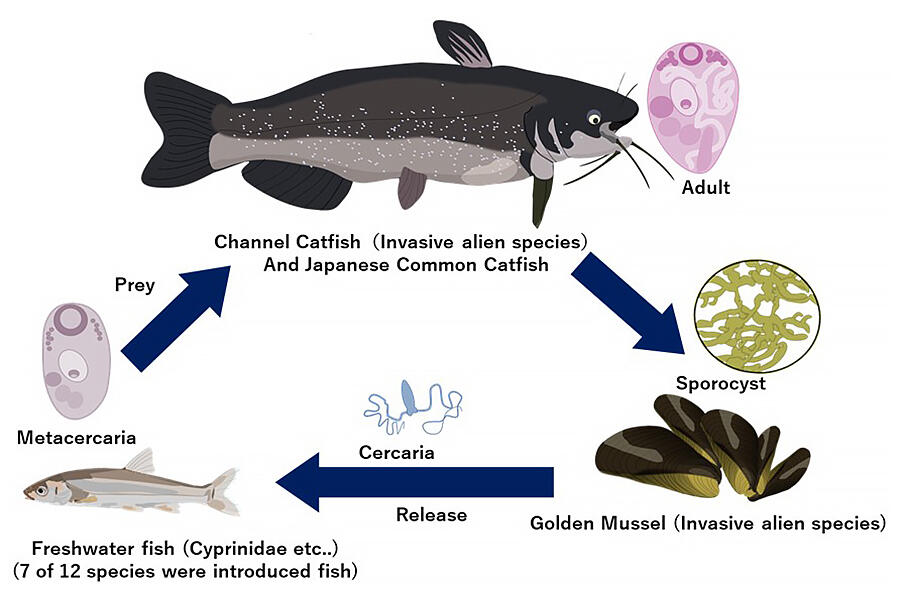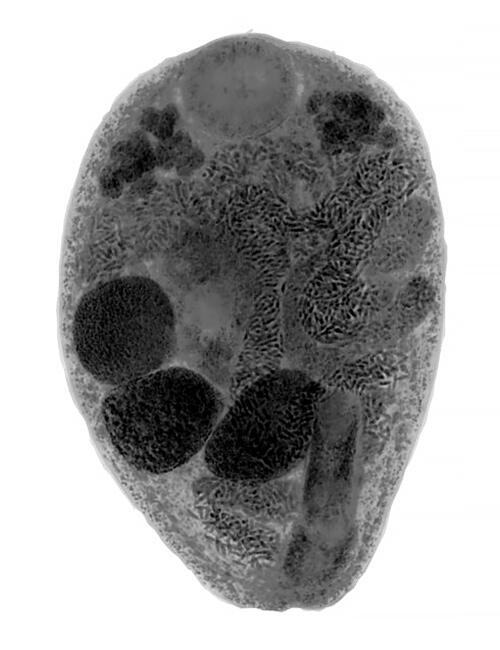A research group led by Associate Professor Tsukasa Waki and graduate student Makito Hayashi of the Faculty of Science, Toho University, in collaboration with the Global Environmental Forum, Nihon University, Asahikawa Medical University, and the University of Shiga Prefecture, has announced that a foreign parasitic worm, Prosorhynchoides ozakii, is infecting native fish in the Tone River system. Surveys of 22 locations, including Lake Kasumigaura, and analysis of the Prosorhynchoides ozakii parasite has revealed that it is infecting native fish such as the Japanese dace, as well as foreign freshwater fish from Japan and abroad, and that golden mussels are the source of the infections. The transfer and release of these organisms may further spread the infection and cause even further declines in native fish species. The results were published in the November 17 issue of the international scientific journal Diseases of Aquatic Organisms.

Illustration by T. Waki and M. Hayashi. Illustration model cooperation: H. Sekine
Prosorhynchoides ozakii is a foreign parasite, and there are no reports of it being parasitic to humans, but it is believed that it has already invaded the Yodo River system together with the golden mussel, which is also an invasive alien species to Japan.
So far, the research group has accidentally discovered adult Prosorhynchoides ozakii from the intestinal tracts of channel catfish (an invasive alien species) and Japanese catfish that were collected in the Tone River system in the process of investigating other parasites. Because Prosorhynchoides ozakii had already settled and was living in the Yodo River system, this indicated that the Tone River system might also be colonized.
Therefore, in order to clarify the life history of Prosorhynchoides ozakii in the Tone River system, from 2019 to 2021, the research group collected golden mussels and freshwater fish at 22 sites in the Tone River system, including Lake Kasumigaura, and conducted survey and identification work (determined by nuclear 28S rDNA and mitochondrial DNA cox1 partial sequence) to determine if larvae were present.
A total of 1,719 golden mussels were collected from 10 sites, of which eight sites were observed to be infected with sporocyst-stage larvae and with migrating cercaria-stage larvae, which is an advanced developmental stage that is capable of parasitizing fish.
700 freshwater fish spread across 24 species were collected from 15 sites, and Prosorhynchoides ozakii metacercaria-stage larvae were detected in the fin bases and livers of 12 fish species from 10 sites. The metacercaria-stage larvae were frequently infecting cyprinid and goby fish species.
From these surveys, it was found that in the Tone River system sporocyst-stage larvae parasitizing golden mussels release cercariae-stage larvae into the water, which then infect (as metacercariae-stage larvae) intermediate hosts, including native and non-native fish such as the Japanese dace, and when these infected fish are eaten by channel catfish and Japanese catfish, they become adults in the intestines of these hosts, which lay eggs in their gut and then the eggs are released into the water with feces, once again infecting the golden mussels.
Channel catfish breed abundantly in the Tone River system, and the research group established that the golden mussel, an alien species that is native to Asia, has become the primary host for Prosorhynchoides ozakii. In addition, native freshwater fish collected showed evidence of severe infection from metacercariae-stage larvae. In general, parasites of non-native species are highly pathogenic to native species that are not resistant to them, and may be a factor in reducing the survival of native freshwater fish.
In addition, because the Yodo River system and the Tone River system are separated by land, the infection is thought to have been spread by humans rather than by natural migration. Although Prosorhynchoides ozakii in the Tone River system is an invasive species, its relatively high genetic diversity makes it appear that it was repeatedly introduced.
Because golden mussels are widely established in rivers in Japan, the spread of Prosorhynchoides ozakii infections could easily occur through the release of infected fish or through humans moving the mussels.

Photo taken by M. Hayashi
According to Waki, "This survey was conducted mainly on the southern side of the Tone River system, so we would like to continue our research on controlling the infection by conducting surveys at other sites to clarify conditions that make it difficult for Prosorhynchoides ozakii to survive. Additionally, in order to prevent the further spread of infection, we are calling on people not to release fish and not to move mussels."
Journal Information
Publication: Diseases of Aquatic Organisms
Title: Invasion of the fish parasite Prosorhynchoides ozakii (Trematoda:Bucephalidae) into Lake Kasumigaura and the surrounding rivers of eastern Japan
DOI: 10.3354/dao03698
This article has been translated by JST with permission from The Science News Ltd.(https://sci-news.co.jp/). Unauthorized reproduction of the article and photographs is prohibited.




